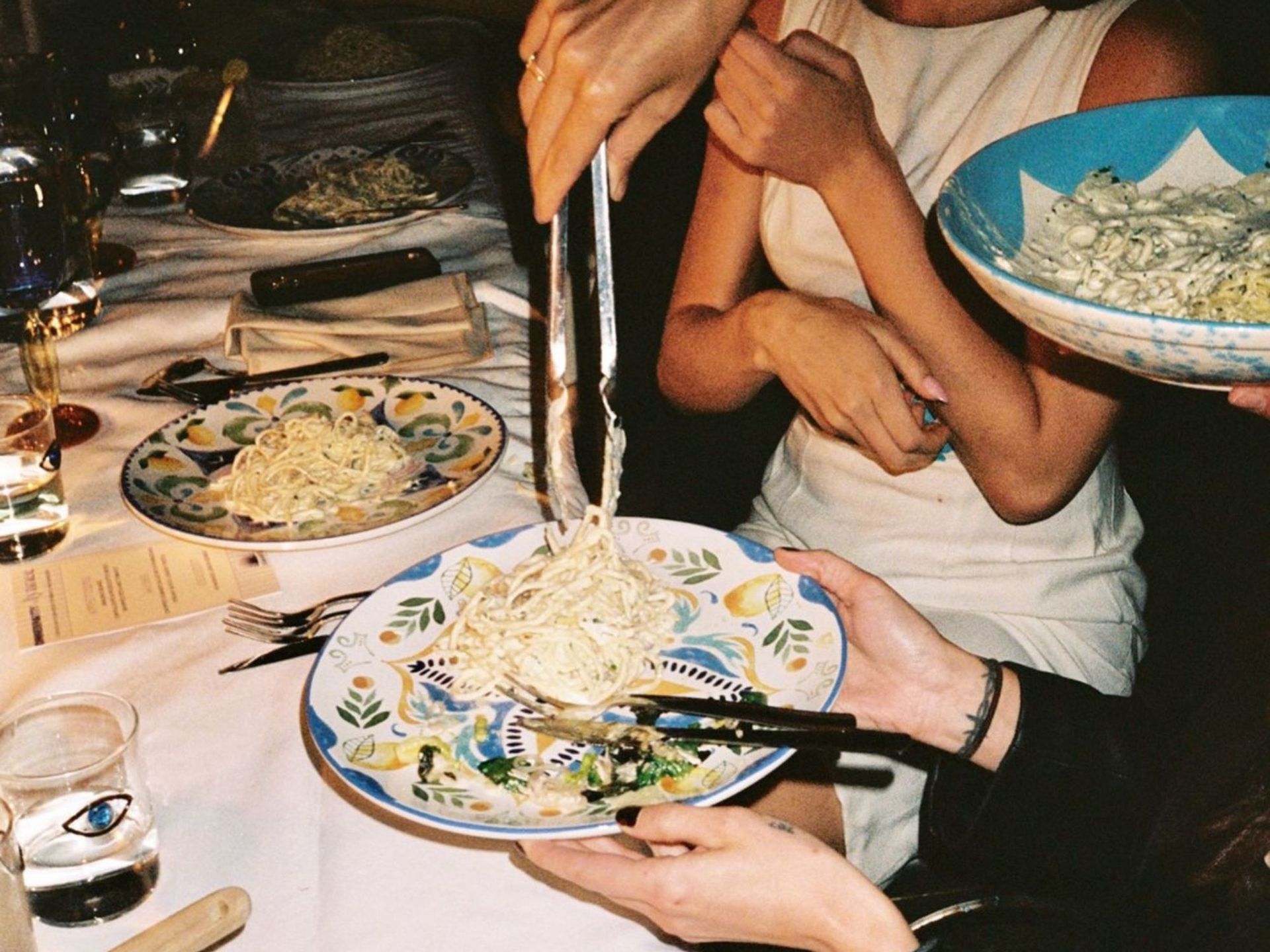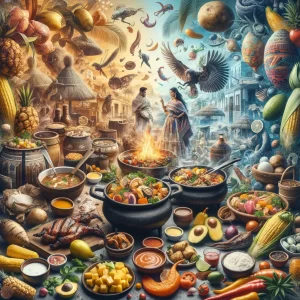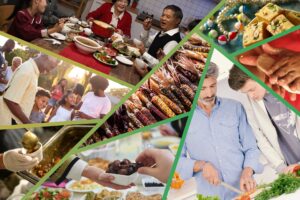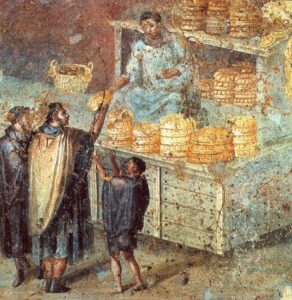Culinary heritage represents more than merely food; it is a rich tapestry composed of the traditions, narratives, and flavors inherent to diverse cultures worldwide, highlighting the significance of food preservation and culinary storytelling.
As globalization poses a significant threat to the preservation of unique culinary practices, it is imperative to recognize the importance of safeguarding these traditions, including traditional recipes and local cuisines.
This article examines the concept of culinary heritage, identifies endangered recipes that are at risk of disappearing, and discusses the initiatives currently underway to protect these invaluable assets, such as culinary conservation and preservation initiatives.
Learn how you can contribute to the preservation of cherished flavors, family recipes, and culinary legacy for the benefit of future generations, ensuring food variety and cultural preservation.
What Is Culinary Heritage?
.jpg_00.jpeg)
Culinary heritage encompasses the traditional recipes, cooking methods, and food practices that define a community’s cultural identity, highlighting the richness of food history, gastronomy, and cultural recipes.
This intricate tapestry of flavors and techniques transcends mere sustenance; it embodies the values, beliefs, and memories of generations, thus contributing to a diverse landscape of culinary arts, culinary diversity, and gastronomic practices.
The preservation of these practices is vital, as it nurtures a sense of belonging and continuity within communities while also deepening our understanding of food culture worldwide, including the importance of food history and culinary diversity.
Why Is It Important to Preserve Culinary Heritage?
Preserving culinary heritage is essential for maintaining culinary diversity, promoting food sustainability, and ensuring that traditional cooking methods and cultural recipes are transmitted through generations, enhancing food identity and culinary scholarship. This conservation not only honors the history of the community but also enriches food culture by integrating local ingredients and flavors that contribute to a distinct sense of place, celebrating indigenous recipes and culinary traditions.
As communities reconnect with their culinary roots, they foster a sense of nostalgia in cooking that reinforces their cultural identity and enhances social cohesion, through initiatives like cultural storytelling and traditional foodways.
In this context, the documentation of recipes serves as an invaluable tool, safeguarding intricate cooking techniques and the narratives associated with each dish from being forgotten, supporting recipe documentation projects and culinary education. Such practices not only facilitate a connection with local traditions and regional dishes but can also inspire future chefs and food enthusiasts, fostering culinary education and chef advocacy.
Culinary heritage has the potential to attract food tourism, drawing visitors interested in experiencing authentic local flavors and traditions, promoting food tourism and culinary initiatives.
Thus, safeguarding these culinary narratives and traditional recipes not only enriches the community’s cultural fabric but also nurtures economic opportunities, contributing to a sustainable future and culinary tourism.
What Are Endangered Recipes?
Endangered recipes refer to culinary traditions, techniques, and dishes that are at risk of being lost due to modernization, evolving tastes, and the decline of traditional cooking practices, including heritage foods and ethnic foods.
These recipes often embody distinct regional dishes, flavors, and culinary methods that are crucial to cultural identity and heritage, emphasizing the role of heritage organizations and food sovereignty. The documentation and revival of these endangered recipes are vital for culinary preservation, as they provide valuable insights into food anthropology, food history, and underscore the importance of traditional diets in fostering community connections.
What Causes Recipes to Become Endangered?
Recipes are increasingly becoming endangered primarily due to globalization, which often results in the homogenization of food systems and the decline of cultural practices associated with traditional cooking and culinary traditions.
As communities increasingly gravitate toward convenience foods and modern culinary trends, the utilization of local ingredients and traditional methods may wane, placing unique recipes and culinary legacy at significant risk. A lack of recipe innovation and adaptation to contemporary dietary preferences further exacerbates the vulnerability of these culinary treasures, highlighting the need for recipe rescue and food innovation.
This trend is particularly evident as popular fast food chains proliferate, overshadowing local establishments that once thrived on regional cuisines and indigenous recipes, which are crucial for culinary tourism.
Additionally, the rise of social media has influenced consumer tastes and eating habits, frequently prioritizing aesthetic appeal over the authenticity of flavors, traditional ingredients, and preparation techniques, impacting culinary storytelling and recipe sharing. While the movement toward healthier eating is beneficial in many respects, it can inadvertently lead to the neglect of traditional recipes that rely on local produce, traditional cooking methods, and distinctive preparation techniques, essential for maintaining culinary roots and food conservation.
Despite these challenges, communities have begun to embrace innovation by leveraging technology, contemporary flavors, and food networks to reimagine their culinary heritage, supporting culinary workshops and recipe storytelling. By capturing the essence of time-honored practices, they are fostering a resurgence of interest in preserving endangered recipes, promoting culinary revival, and cooking heritage.
How Many Recipes Are Considered Endangered?
Quantifying the exact number of endangered recipes presents a significant challenge, as this figure varies widely across different cultures and regions, emphasizing the need for culinary research and food studies. Nevertheless, numerous culinary organizations and researchers are actively engaged in documenting these invaluable culinary legacies globally, through heritage foods initiatives and cultural dishes preservation.
These initiatives not only focus on the recipes themselves but also emphasize the rich food history, culinary diversity, and the diverse global cuisines they encompass, supporting culinary scholarship and cultural recipes. As culinary preservation efforts expand, awareness of these endangered recipes grows, fostering community engagement, cooking classes, and the revival of culinary diversity.
Organizations such as Slow Food and the UNESCO Intangible Cultural Heritage program are leading these efforts, working to establish comprehensive databases that celebrate traditional cooking methods, recipe documentation, and the narratives associated with them.
Culinary heritage programs frequently involve local communities in culinary workshops, recipe documentation projects, and documentation projects, thereby cultivating a sense of pride and ownership over their gastronomic practices and culinary heritage.
Furthermore, culinary festivals have emerged as dynamic platforms for promoting these endangered recipes, highlighting their cultural significance and inspiring a new generation of chefs and home cooks to explore these traditional flavors and regional dishes.
By facilitating interactions among culinary artisans, chefs, and food enthusiasts, such initiatives not only preserve recipes but also revitalize local economies and enhance cultural appreciation, supporting culinary nonprofits and local food movements.
What Are the Efforts to Save Endangered Recipes?
Efforts to preserve endangered recipes are multifaceted and encompass various initiatives, such as recipe preservation projects, culinary heritage festivals, and grassroots food activism aimed at revitalizing traditional cooking practices and culinary roots.
Community networks are essential in promoting recipe sharing, culinary education, and cultural preservation, thereby ensuring that knowledge is transmitted across generations.
Additionally, food influencers and social media platforms play a substantial role in raising awareness about endangered recipes, fostering a renewed interest in culinary traditions and cooking traditions.
1. Oral History and Documentation
.jpg_01.jpeg)
Oral histories and documentation play a crucial role in the preservation of endangered recipes, as they capture the narratives and techniques associated with traditional cooking that may not be documented in written form, supporting recipe archiving and culinary storytelling.
Involving the community in food literacy initiatives ensures that these culinary traditions are effectively articulated and transmitted, thereby fostering a deeper understanding of their cultural significance and historical cooking. Culinary education programs can further support this endeavor by integrating the study of oral histories and food histories into their curricula, enhancing culinary scholarship and food craftsmanship.
These initiatives not only give the power to local cooks and chefs to share their stories and recipes but also establish a platform for cultural exchange and culinary initiatives, thereby enriching the dining experience and taste preservation.
Successful documentation efforts, such as community cookbooks and oral history projects, often lead to a renewed interest in traditional cooking methods, recipe collections, and inspiring younger generations to connect with their cultural heritage.
Such projects enhance food literacy by emphasizing the intricate relationship between culture, history, gastronomy heritage, and cuisine. When individuals engage in the preservation of these culinary legacies, they contribute to a sense of belonging and identity, ensuring that the traditional flavors and narratives of their communities continue to thrive for generations to come.
2. Recipe Preservation Projects
Recipe preservation projects are essential for archiving culinary traditions, food preservation societies, and safeguarding endangered recipes for future generations. These initiatives frequently involve the creation of community cookbooks that compile traditional recipes, cultural recipes, and narratives, thereby fostering a sense of ownership and pride in local heritage.
Food activism can significantly contribute to advocating for recipe preservation initiatives, food conservation, and raising awareness about the importance of culinary heritage.
Such initiatives not only document culinary legacies, recipe heritage, and culinary storytelling but also promote collaboration among local cooks, families, and cultural organizations. By bringing together a diverse array of recipes and techniques, these cookbooks serve as invaluable resources that reflect the unique flavors, traditional foodways, and histories of the community.
The process of gathering individuals to create these cookbooks strengthens community ties, food identity, and recipe exchange, as participants share personal anecdotes and the cultural significance associated with each recipe.
This collaborative spirit exemplifies how food can bridge generational divides, ensuring that cherished family recipes, cooking techniques, and time-honored cooking methods are nurtured and passed on. Ultimately, these efforts contribute to a richer tapestry of cultural identity, culinary heritage, and culinary expression through the medium of culinary expression.
3. Culinary Heritage Festivals and Events
Culinary heritage festivals and events serve as essential platforms for the celebration and preservation of endangered recipes, while simultaneously fostering community engagement and promoting food tourism. These gatherings emphasize regional cuisine and highlight local ingredients, offering attendees opportunities to experience and appreciate diverse culinary cultures and traditional methods.
By connecting individuals to their culinary roots, these events play a critical role in promoting culinary diversity and raising awareness about the importance of safeguarding traditional cooking practices through recipe documentation and culinary storytelling.
The impact of these festivals extends beyond the immediate enjoyment of food; they also facilitate a deeper understanding of the historical and cultural contexts surrounding various culinary traditions and endangered cuisines. Events such as the National Cherry Blossom Festival in Washington, D.C., and the Italian Heritage Festival in Cleveland not only attract tourists but also actively engage local communities through workshops and demonstrations that educate attendees about preparation techniques and the narratives behind traditional dishes.
By providing hands-on learning experiences, culinary heritage festivals inspire a new generation of chefs and food enthusiasts, creating a ripple effect that has the potential to preserve endangered recipes for years to come. These festivals exemplify the essence of culinary tourism by promoting local economies while nurturing a sense of pride in cultural identities and regional dishes.
4. Social Media and Online Communities
Social media and online communities have emerged as significant tools for the preservation of endangered recipes, facilitating culinary storytelling and the exchange of traditional cooking methods across global food networks and recipe sharing platforms.
Through platforms dedicated to recipe sharing and social interaction, individuals can connect, collaborate, and promote grassroots movements that advocate for culinary preservation efforts and the revival of cultural recipes. These digital spaces not only encourage the sharing of recipes but also foster a greater appreciation for diverse culinary heritages.
Platforms such as Instagram, Facebook groups, and specialized forums provide users with opportunities to rediscover forgotten cuisines while engaging with others who share a passion for food history and food preservation initiatives.
Notable initiatives, including Heritage Cookbooks and the Slow Food global movement, have effectively utilized these digital channels to highlight traditional dishes that are at risk of being lost, thereby contributing to the preservation of traditional foodways and culinary legacy.
By involving community members in collaborative cooking sessions and recipe challenges, these initiatives create dynamic environments that inspire a new generation to explore and celebrate their cultural food legacies. Such online engagement cultivates a sense of belonging and encourages individuals to document and preserve their family’s culinary traditions for the benefit of future generations through recipe archiving and food conservation efforts.
Why Are Some Recipes Difficult to Preserve?
Certain recipes present significant challenges for preservation due to various factors, including the absence of written instructions, the unavailability of traditional ingredients, and the gradual erosion of the cultural context that underpins these culinary traditions, highlighting the importance of food preservation and cultural preservation efforts.
As food systems continue to evolve and modernize, many traditional diets and cooking methods encounter difficulties in maintaining their authenticity. This raises important concerns regarding food conservation and the sustainability of these culinary practices, emphasizing the need for preservation initiatives and culinary education.
The relationship between recipe innovation and preservation necessitates careful consideration to uphold the integrity of these dishes, balancing the need for food innovation with the conservation of culinary traditions.
1. Lack of Written Instructions
The absence of written instructions represents a substantial obstacle to the preservation of numerous traditional recipes, which frequently depend on oral history and the transmission of knowledge across generations. This reliance on memory and personal experience can result in variations in cooking methods and ingredient usage, thereby complicating the efforts to accurately document these culinary practices through recipe documentation and food studies.
It is essential to understand the role of oral history within food anthropology to effectively address these challenges and ensure the preservation of traditional cooking techniques and historical cooking practices.
For example, recipes for traditional dishes such as hand-rolled pasta or family-specific stews are often conveyed verbally, leading to unique variations that may never be formally documented in cookbooks, highlighting the importance of recipe heritage and culinary storytelling.
Communities can confront this challenge by actively recording oral histories, organizing cooking workshops, and encouraging home cooks to share their techniques in both written and digital formats. This approach can create a living archive of these culinary treasures and foster a sense of food identity and cultural preservation.
Furthermore, emphasizing the importance of sharing these recipes can foster a sense of community and ensure that future generations appreciate and carry on these cherished traditions and culinary heritage through recipe rescue and taste preservation.
2. Ingredients and Techniques No Longer Used
.jpg_10.jpeg)
The decline in the availability of local ingredients and traditional cooking techniques poses a significant challenge to the preservation of recipes, as many endangered dishes depend on specific flavors and methods that may no longer be widely practiced, impacting food variety and cultural dishes.
As food systems continue to globalize and individual preferences evolve, the distinctiveness of regional cuisines risks being overshadowed, resulting in a loss of culinary diversity and gastronomy heritage. Consequently, efforts to revive traditional techniques and promote the utilization of local ingredients are essential for maintaining the integrity of these recipes and supporting food sovereignty.
For example, certain artisanal cheeses and handcrafted breads are witnessing a decline in traditional practices due to the increasing prevalence of mass production, which leads to the disappearance of unique flavors and the cultural narratives associated with them, highlighting the need for food craftsmanship and preservation initiatives.
To combat these trends, initiatives such as community-supported agriculture and culinary workshops are emerging, aimed at reconnecting chefs and consumers with local farmers and heritage foods. Organizations advocating for the protection of traditional methods not only cultivate an appreciation for these culinary arts but also inspire young cooks to embrace and innovate with regional specialties, ensuring that these practices will not only survive but thrive in the contemporary culinary landscape through chef collaborations and food revival efforts.
3. Cultural and Historical Context Lost
When the cultural and historical context surrounding recipes is lost, the significance of those dishes diminishes, which poses challenges to preserving their essence and meaning, emphasizing the importance of cultural storytelling and food heritage projects.
Culinary storytelling plays a crucial role in reconnecting individuals with their food heritage, evoking nostalgia in cooking and fostering a deeper appreciation for traditional recipes. Efforts to engage communities and educate individuals about the rich food history associated with these dishes are essential to maintaining their ongoing relevance and supporting cultural preservation.
Notable initiatives, such as community cookbooks and local food festivals, seek to bridge generational gaps by encouraging participants to share their personal narratives connected to specific meals. These endeavors not only celebrate culinary diversity but also provide a platform for older generations to impart their knowledge to younger cooks, fostering an appreciation for culinary scholarship and food legacy.
By fostering an environment where stories accompany each recipe, individuals are invited to partake in a collective memory-making process, ensuring that traditional dishes endure over time and remain relevant within the ever-evolving culinary landscape through culinary conservation and food identity preservation.
How Can Individuals Contribute to Preserving Culinary Heritage?
Individuals can make a significant contribution to the preservation of culinary heritage by actively participating in recipe sharing, engaging in culinary education, and producing community cookbooks that celebrate local flavors and traditional dishes, supporting food preservation societies and culinary initiatives.
Cross-generational cooking is particularly valuable, as it facilitates the transfer of knowledge between family members, ensuring that cherished recipes and cooking methods are not lost over time, contributing to recipe revival and food heritage projects.
By promoting food literacy and encouraging others to appreciate their culinary roots, individuals play a vital role in sustaining their community’s cultural identity, fostering food education and culinary heritage initiatives.
1. Recording Family Recipes
Recording family recipes serves as a significant means of preserving culinary heritage, ensuring that cherished food memories and traditional cooking practices are documented for future generations. By capturing the stories and techniques behind these recipes, families can celebrate their culinary diversity and maintain a connection to their cultural roots, supporting recipe documentation projects and culinary storytelling.
This practice honors the past while fostering nostalgia in cooking, encouraging individuals to share their culinary traditions with others through recipe storytelling and preservation initiatives.
The process of documenting these recipes can take various forms, ranging from handwritten notebooks to digital archives, thereby providing a personalized touch that reflects each family’s unique history. It is advisable for families to include not only the ingredients and methods but also the special anecdotes associated with each dish, as these narratives enhance the experience of cooking and sharing, supporting culinary research and recipe archiving.
For those seeking to promote this tradition, hosting community potlucks or recipe exchanges can be equally valuable. This approach not only preserves the family’s legacy but also strengthens relationships within the community, creating a rich tapestry of shared culinary stories that celebrate diversity and inclusion through culinary nonprofits and local food movements.
2. Sharing Recipes with Others
Sharing recipes with others plays a crucial role in preserving culinary heritage, as it encourages community engagement and facilitates the exchange of culinary knowledge and traditions. Initiatives such as community cookbooks and culinary storytelling provide individuals with opportunities to forge connections and strengthen local food networks, ensuring that traditional recipes, including endangered recipes, are celebrated and preserved through recipe documentation and culinary storytelling.
This collaborative approach not only enriches the culinary landscape of the community but also enhances efforts in heritage conservation, fostering culinary diversity and food sustainability.
In today’s digital age, social media platforms function as dynamic venues for individuals to share their culinary creations and explore diverse recipes from around the world. This virtual interaction enables communities to connect on a global scale while emphasizing regional specialties, unique family recipes, and local ingredients, promoting food revival and culinary tourism.
Culinary events, including potlucks and food festivals, offer a tangible means for individuals to gather, share dishes, and experience the rich array of flavors that reflect their heritage. By participating in these activities, individuals not only enjoy a variety of delicious foods but also promote understanding and appreciation for each other’s culinary backgrounds, supporting cultural preservation and food variety.
3. Participating in Culinary Heritage Events
Participation in culinary heritage events, such as food festivals and community kitchens, enables individuals to engage with local culinary traditions and contribute to the preservation of endangered recipes. These events serve as essential platforms for culinary education and food activism, fostering a heightened appreciation for traditional cooking methods, food preservation, and the cultural significance of regional cuisines and cultural recipes.
Through active involvement, individuals can help raise awareness and cultivate a sense of community surrounding culinary heritage, supporting heritage foods and culinary conservation.
Such gatherings frequently include:
- Workshops
- Cooking demonstrations
- Tastings
These activities showcase the diverse array of flavors and techniques that have been passed down through generations. For example, festivals dedicated to specific regional cuisines not only promote local ingredients but also educate attendees about their historical context, cultural recipes, and nutritional benefits, encouraging taste preservation and traditional foodways.
These experiences create opportunities for dialogue surrounding food sovereignty and encourage sustainable practices, linking food traditions to broader social issues. By participating, community members not only celebrate their unique food narratives but also contribute to a collective effort that nurtures cultural identity, supports traditional ingredients, and promotes environmental stewardship.
Frequently Asked Questions
.jpg_11.jpeg)
What is meant by “endangered recipes” when it comes to preserving culinary heritage?
Endangered recipes refer to traditional or cultural dishes that are at risk of being lost due to factors such as changing food trends, lack of documentation, and the passing of generations. Efforts to save these recipes aim to ensure they are not forgotten and can continue to be enjoyed by future generations.
What are some common efforts being made to preserve culinary heritage and endangered recipes?
Some common efforts include oral history projects, recipe digitization, culinary archives, and cooking classes or workshops that focus on traditional recipes and endangered cuisines. These efforts help to document and pass down recipes that may otherwise be lost, enhancing food history and culinary legacy.
Why is it important to save endangered recipes?
Preserving culinary heritage and endangered recipes is important for cultural preservation and understanding. These recipes often hold significant historical, social, and traditional value, and losing them means losing a part of our cultural identity and culinary roots.
Are there any challenges in preserving culinary heritage and endangered recipes?
Yes, there are several challenges, including a lack of documentation, changes in food culture and preferences, and the passing of older generations who hold the knowledge of these recipes. Additionally, some traditional ingredients may become difficult to source, affecting food artisans and making it harder to recreate the original dishes.
How can individuals contribute to saving endangered recipes?
Individuals can contribute by documenting family recipes, participating in oral history projects, and sharing traditional recipes with others. Supporting local cooks and restaurants that specialize in traditional dishes can also help to preserve culinary heritage and promote recipe exchange and cooking traditions.
Are there any organizations or initiatives focused on preserving culinary heritage and endangered recipes?
Yes, there are numerous organizations and initiatives around the world dedicated to preserving culinary heritage and endangered recipes. Some notable examples include the Slow Food movement, the Culinary Historians of Canada, and the Endangered Archives Programme by the British Library, all of which contribute to food preservation societies and preservation initiatives.

My name is Bruno, I have been a writer for 5 years and I work with website creation. My goal is to provide true information to readers. In fact, on this site I write about cultures and traditions, which I have been passionate about since childhood.




